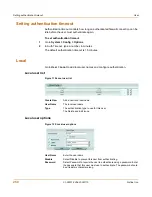
264
01-28011-0254-20051115
Fortinet Inc.
Phase 1
VPN
Pre-shared Key
If Pre-shared Key is selected, type the preshared key that the
FortiGate unit will use to authenticate itself to the remote peer or
dialup client during phase 1 negotiations. You must define the
same value at the remote peer or client. The key must contain at
least 6 printable characters and should only be known by network
administrators. For optimum protection against currently known
attacks, the key should consist of a minimum of 16 randomly
chosen alphanumeric characters.
Certificate Name
If RSA Signature is selected, select the name of the server
certificate that the FortiGate unit will use to authenticate itself to
the remote peer or dialup client during phase 1 negotiations. To
obtain and load the required server certificate, see
“Certificates”
on page 279
.
Peer Options
To accept connections without checking peer IDs, select Accept
any peer ID.
To grant access to one or more remote peers or FortiGate dialup
clients based on a peer ID, select Accept this peer ID and type
the identifier. This value must be identical to the value in the
Local ID field of the phase 1 remote gateway configuration on the
remote peer or FortiGate dialup client. For details, see the
“Enabling VPN peer identification” section of the
FortiGate VPN
Guide
.
If you are configuring authentication parameters for
FortiClient dialup clients, refer to the
Authenticating FortiClient
Dialup Clients Technical Note
.
To grant access to dialup users based on the name of a dialup
group, select Accept peer ID in dialup group and select the name
of the group from the list. You must create the user group before
it can be selected here. See
“User” on page 249
. For more
information about using peer IDs to authenticate dialup users,
see the “Enabling VPN peer identification” section of the
FortiGate VPN Guide
.
To authenticate one (or more) remote peers or dialup clients
based on a particular (or shared) security certificate, select
Accept this peer certificate only and select the name of the
certificate from the list. For details, see the “Enabling VPN access
for specific certificate holders” section of the
FortiGate VPN
Guide
. The certificate must be added to the FortiGate
configuration through the
config user peer
CLI command
before it can be selected here. For more information, see the
“config user” chapter of the
FortiGate CLI Reference Guide
. If the
remote VPN peer or client has a dynamic IP address, set Mode to
Aggressive.
Select Accept this peer certificate group only to use a certificate
group to authenticate remote peers and dialup clients that have
dynamic IP addresses and use unique certificates. Select the
name of the group from the list. For details, see the “Enabling
VPN access for specific certificate holders”
section of the
FortiGate VPN Guide
. The group must be added to the FortiGate
configuration through the
config user peer
and
config
user peergrp
CLI commands before it can be selected here.
For more information, see the “config user” chapter of the
FortiGate CLI Reference Guide
. When the remote peers and
clients have dynamic IP addresses, you must set Mode to
Aggressive.
Advanced
You may retain the default settings unless changes are needed to
meet your specific requirements. See the “Defining IKE
negotiation parameters” and “Configuring the phase 1 IKE
exchange” sections of the
FortiGate VPN Guide.
Summary of Contents for FortiGate 1000A
Page 80: ...80 01 28011 0254 20051115 Fortinet Inc FortiGate IPv6 support System Network ...
Page 88: ...88 01 28011 0254 20051115 Fortinet Inc Dynamic IP System DHCP ...
Page 122: ...122 01 28011 0254 20051115 Fortinet Inc FortiManager System Config ...
Page 248: ...248 01 28011 0254 20051115 Fortinet Inc Protection profile Firewall ...
Page 260: ...260 01 28011 0254 20051115 Fortinet Inc CLI configuration User ...
Page 380: ...380 01 28011 0254 20051115 Fortinet Inc CLI configuration Log Report ...
Page 392: ...392 01 28011 0254 20051115 Fortinet Inc Glossary ...

































